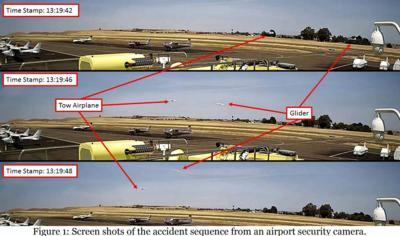Glider Canopy Opens, Disastrous Sequence Follows
Location: Byron, CA Accident Number: WPR20LA141
Date & Time: 05/09/2020, 1319 PDT Registration: N4116Y
Aircraft: BELLANCA 8GCBC Injuries: 1 Fatal
Flight Conducted Under: Part 91: General Aviation - Glider Tow

On May 9, 2020, about 1319 Pacific daylight time, a Bellanca 8GCBC, N4116Y, was destroyed when it was involved in an accident at Byron Airport (C83), Byron, California. The pilot was fatally injured. The airplane was operated as a Title 14 Code of Federal Regulations Part 91 glider tow flight.
The pilot of the glider being towed reported to the National Transportation Safety Board investigator-in-charge that the accident flight was his second flight of the day. He stated that a pre-takeoff checklist was performed and that he verified the gliders canopy was closed and locked. Following a normal takeoff, the tow airplane pilot initiated a slight right turn, and shortly after, the glider canopy opened. The pilot stated that the canopy began "flapping" open and closed and he attempted to secure it and control the glider. He added that he briefly became disoriented and turned back toward the airport.
A witness stated that the visibility from the glider to the tow airplane "appeared to potentially have been an issue, as there was a 30-40° angle on the tow line." The witness added that as both the tow airplane and glider neared the end of the runway, the tow pilot cut the tow line, however, was in an "aggressive nose-low attitude" and impacted the ground shortly after in a "45° nose-low attitude."

Airport security camera recordings, as shown in figure 1, captured the accident sequence. The recordings showed that the tow airplane became airborne about mid length of the runway and proceeded in a shallow climb with the glider in trail and at a similar altitude. About 7 seconds after the tow airplane became airborne, the glider pitched upward and ascended, while the tow airplane remained in a shallow climb. About 3 seconds later when the tow airplane began a shallow descent. About 2 seconds later, the tow airplane and glider appeared to remain level, with the glider at a higher altitude than the tow airplane, for about 4 seconds, when the tow airplane and glider appeared to descend.
The glider began to ascend about 4 seconds later, while the tow airplane pitched downward to a nose low attitude, impacted the runway, and nosed over, where a post impact fire ensued. The glider executed a 180° right turn and landed on runway 12 uneventfully.
Examination of the accident site by a Federal Aviation Administration inspector revealed that the airplane impacted the departure end of runway 30 and came to rest inverted. The fabric covering of the airplane was mostly consumed by fire, however, the primary structure of the wings, fuselage, and empennage were intact. All flight control cables appeared to remain attached to their respective flight controls. Photos provided by wreckage recovery personnel showed that the rope cutting mechanism on the tow airplane was engaged. Airport management reported that the tow rope was located about 80 feet beyond the main wreckage of the tow airplane in the grassy area adjacent to the runway. Photos of the tow rope showed that one end appeared to be cut, while the opposing end was intact. The wreckage of the tow airplane was recovered to a secure location for further examination.
 ANN's Daily Aero-Term (04.28.24): Airport Marking Aids
ANN's Daily Aero-Term (04.28.24): Airport Marking Aids Aero-News: Quote of the Day (04.28.24)
Aero-News: Quote of the Day (04.28.24) ANN's Daily Aero-Linx (04.28.24)
ANN's Daily Aero-Linx (04.28.24) Aero-News: Quote of the Day (04.29.24)
Aero-News: Quote of the Day (04.29.24) ANN's Daily Aero-Linx (04.29.24)
ANN's Daily Aero-Linx (04.29.24)




